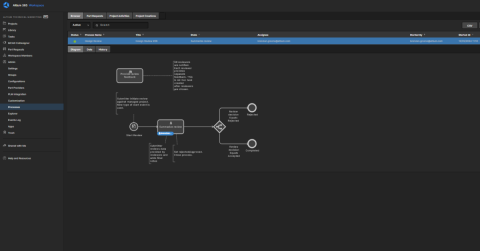Supply Chain Database to Workspace Data Synchronization
Summary:
This video demonstrates the process to synchronize a supply chain database to a Workspace in Altium 365. Altium 365 allows users to link components to real world parts using part choices. Parts are stored in a component library. By knowing the manufacturer information for a part, users can check part stock, prices, and the lifecycle of each component, allowing them to manage part obsolescence for projects.
The video begins by adding a resistor from a component template as a part choice in Altium Designer. Next, two resistor components and their parameters are chosen and selected for comparison. Then, a resistor is added to a project and the Active BOM, and a selection for it is found in Octopart.
Lastly, the video discusses the process to import data for parts which are unavailable in Octopart by uploading a spreadsheet from a supplier into a custom data synchronization in an Altium 365 Workspace. After this is complete, these new components are displayed in the Manufacturer Part Search Panel. This data sync can be scheduled to update daily to maintain the latest information from an ERP System or spreadsheet. Thus, this video helps users sync their databases and transition lesser known part choices into an Altium 365 Workspace.
Transcript:
00:00:00:00 - 00:00:24:10
In Altium 365 you can store your component library and link the components to real world parts using part choices. A part choice consists of a manufacturer name and a manufacturer part number, and we use this information to link it and bring in the information from your part providers about the current stock, the current price, and the lifecycle. And you can use this for obsolescence managers for your projects.
00:00:24:10 - 00:00:45:02
Right, you can check in a project which parts have which prices. Are prices going up or down or are lifecycles going bad? So it links it to the real world. Let's switch to Altium Designer to see how you can add a component with a part choice. Let’s create a resistor.
00:00:45:03 - 00:00:52:02
It's loaded from my component template and I'm going to add a part choice.
00:00:52:04 - 00:01:03:12
In this case I will make a 100 ohm resistor and an 0402 package.
00:01:03:13 - 00:01:26:01
I’ve got a list of components, right, and the Yageo looks all right. And, I like this Vishay Dale too, so I hold control key, click it. The system allows me to compare these, and I like both, they are a valid alternative.
00:01:26:02 - 00:01:57:04
I can bring in the parameters which is nice. Okay, and now I have two part choices for this component. It can be this Yageo with this part number, this Vishay Dale. I can check the lifecycles to stock the prices and well make the best choice for the project where I'm using maybe one have as a minimum order quantity and the order doesn't, which would help me make the best choice.
00:01:57:05 - 00:02:06:03
This information can then be used in a project. I have a project open and when I place any component.
00:02:06:04 - 00:02:10:07
In open Active BOM.
00:02:10:09 - 00:02:30:09
Then I can see the part. I can see, well, it can be this Kyocera or this TDK. The TDK seems to not have any suppliers or would probably be a bad choice. And there is a list of suppliers for the Kyocera where Mouser would be the top pick in this case, as it has the stock.
00:02:30:11 - 00:03:06:08
And we can have BOM checks to check for problems in your supply chain here. All right, what happens if a component isn't available in Octopart? So let's say, I'm doing big batches and make a production run in China. And China has to own suppliers like LCSC Electronics and you have this nice list of sensor chips that I like, and let's say I want to add a part choice for this. You can see that Octopart actually knows this but there's very little information.
00:03:06:08 - 00:03:31:01
It says it's an LDO, it's a sensor and it's just not really up to date. I want to bring this in with the information that I get from my supplier LC. LCSC allows me to download a table, which is nice, and I got this table over here, right, with all the information, part numbers.
00:03:31:04 - 00:03:55:05
And I edit supplier currency. And I can use this Excel sheet to upload. So let's save it, and to do this I need to go to extension and update first. And make sure
00:03:55:06 - 00:04:22:00
That under configure the custom data synchronization is enabled. So you need to enable that. And when you have it enabled and under file new, there will be an option custom part, provide a synchronization configuration. This can be used to upload parts into your custom database and use as part source. So I can choose access files, excel files, comma separated values.
00:04:22:02 - 00:04:39:00
Or I can even do a connection string to your ERP system. If you hold internal stock or your purchasing team might be working on this database, keeping it up to date. In my case, I will choose Excel.
00:04:39:01 - 00:05:12:14
I need the Properties Panel. To enable the sheet and select my fields manufacturer’s name is, let's see, many manufacturers, manufacturer part numbers, would be MPN, the supplier. The supplier part number description fields is what I need.
00:05:13:00 - 00:05:31:05
I can see the quantity for how much stock they have. Let's see if it's in here. Its availability, we have a currency field, and there's a price field.
00:05:31:06 - 00:06:11:07
If there would be price breaks I could add for ten under the 1000. But in this case I don't have it in my data. All right, so I want this information to be available into my Altium 365 Workspace. So I can simply execute this. All right, so for now I need to sign out of the workspace and sign in to enable the custom supplier as workspace data are read when you sign in.
00:06:11:08 - 00:06:24:10
All right, and from now on in the manufacture part search, I can simply go to the custom part provider category.
00:06:24:12 - 00:06:35:00
And now it will show all the parts that are uploaded here, just like Octopart Parts.
00:06:35:01 - 00:07:19:07
I can go to Octopart there or I can check the SBN and get the price from supplier in Euros, and the stock. And this information can be brought in anywhere. And this data can also be kept up to date. Right. We have this part sync over here, and if I save the part sync file. Save it here then I can even schedule it so that it runs every day, automatically, and updates the information in the part chart in the part provider with the latest from your Excel Sheet or from your internal ERP system if that's updated daily.
00:07:19:09 - 00:07:34:14
All right, that's it. That's how you can work with a custom part sync. And, well, get your lesser known parts as a part choice into your Altium 365 Workspace. Thanks for watching. I wish you a nice day. Bye.



